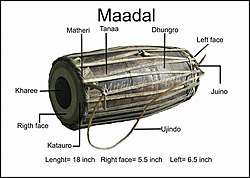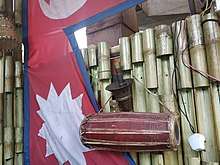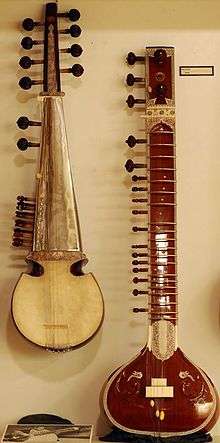Madal
The madal is a folk musical instrument of Nepal . The Madal (Nepali: मादल), is used mainly for rhythm-keeping in Nepalese folk music. It is very popular and widely used as hand drum in Nepal. The Madal consists of a cylindrical body with a slight bulge at its center and heads at both ends, one head larger than the other. It is usually played horizontally in a seated position, with both heads played simultaneously.
 |
Madal is a National Instrument of Nepal. This typical Nepalese percussion instrument is the backbone of most Nepali folk music. The well-known Nepali musician Ranjit Gazmer introduced this instrument to Bollywood music, when he started working under Rahul Dev Burman, and has used it in numerous Bollywood songs such as 'Hum dono do premi duniya chhod chale', 'Kanchi re kanchi re' and many others. There is also a madal drum among certain Adivasi groups.
Nomenclature and construction
The ancient name of Madal was Mardal (मर्दल in Nepali).
Typically, a wooden log is carved so as to form a hollow cavity, called Ghar (घर). The heads of the drum are made of double-layered goat skins, and a black paste made of flour, iron filings, and egg is burned in to a circular area in the center of each head. This circle adds weight to the head and significantly alters the sound of the drum, giving it a bell-like quality. The heads are fixed to the body of the drum by leather strips running the length of the body, and an additional loose strip of leather which can be looped behind the performer's knees while playing. [2] The larger and smaller heads are often referred to as male and female respectively.[3]
See also
References
- Darnāla, Rāmaśaraṇa (2004). Nepālī bājā (1. saṃskaraṇa. ed.). Kāṭhamāḍauṃ: Ratna Pustaka Bhaṇḍāra. ISBN 99933-0-463-8.
- "Nepalese Madal". Archived from the original on 2012-03-27. Retrieved 2011-07-16.
- Kan̐ḍela, Rāmaprasāda (2004). Nepālī lokabājā (Saṃskaraṇa. 1. ed.). Kāṭhamāḍauṃ: Nepālī Lokabājā Saṅgrahālaya. ISBN 99933-877-3-8.
Notes
- Anmol, Amrita Priyamvada (2009). Encyclopaedia of Indian Musical Instruments, Vols. 1 to 3 :, xxxvi, 720 p, 3 Vols, figs, ISBN 9788126140770
- L.S. Rajagopalan, L.S. (2010). Temple Musical Instruments of Kerala. Edited by A. Purushothaman and A. Harindranath, Sangeet Natak Akademi, xvi, 168 p, ISBN 8124605440

